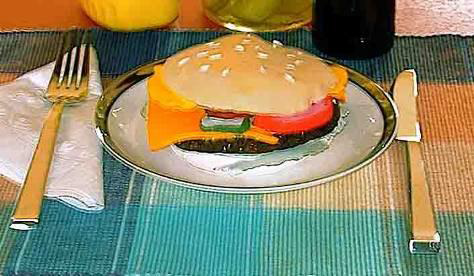Goal (Terminal Objective):
Students will create works of art demonstrating their understanding of pop art and color mixing.
Objective:
Each student will design and sculpt a realistic representation of common food items.
National Standards:
Visual Arts Grades 9-12 Content Standard 1: Understanding and applying media, techniques, and processes
Visual Arts Grades 9-12 Content Standard 3: Choosing and evaluating a range of subject matter, symbols, and ideas
Visual Arts Grades 9-12 Content Standard 4: Understanding the visual arts in relation to history and cultures
Visual Arts Grades 9-12 Content Standard 5: Reflecting upon and assessing the characteristics and merits of their work and the work of others
Purpose:
Students will explore the concepts of realism in art, paying special attention to detail and color.
Materials:

#22-2003Sculpt-It! White re-sealable Tub

#24-2499 Acrylic Paint

#56-6012 Sargent Rainbow Natural Hair Brush Sets

#22-9111 11 ct. Sculping Tool Set
Images of common food items from magazines, library or internet.
New Vocabulary:
Realism, Pop Art
Time:
This lesson may be modified to last from one to three hours, depending upon size and complexity expectations.
Introduction and Motivation (Set):
Students will view exemplars of pop art sculptures from Jasper Johns, Red Grooms, and Claes Oldenburg.
Teacher introduces the concept of Pop Art and how American popular culture of the 1960’s is represented in sculpture as represented by the historical exemplars.
Teacher initiates a discussion about examples of pop art that monumentalize aspects of American culture and the American experience. Food is an important part of American life; what kinds of foods are representative examples of the American experience today?
Instruction:
Teacher asks students to think of representative American foods, taking suggestions from the class until there are at least as many suggestions as class members. During the process, one student is recording each suggestion on a slip of paper. Then, each student randomly selects a paper from a “hat”. The student will plan and execute the food item on the paper.
Teacher organizes the classroom to facilitate students’ easy, orderly access to materials.
Activities:
There are two ways a teacher may go about teaching this lesson. Teachers can boil eggs ahead of time for their class to use.
OR
(1) Guided Practice:
- Students create thumbnail sketches of food items, paying careful attention to detail.
- Students select the most promising image with the help of the teacher. Student visualizes and draws three views of the chosen food item (front, side, rear).
- Using Sargent Sculpt-It, students model a replica of their food subject. Completed sculptures should be highly detailed and 4-6 inches in at least two dimensions. Allow sculptures to air dry.

- Students use Sargent paints to add color to the finished sculptures. Stress color accuracy by mixing paints carefully. Allow sculptures to air dry.

- Clean up with soap and water.
(2) Independent Practice and Check for Understanding:
Teacher circulates among the working students visually recording (checklist) students demonstrating understanding of objectives, asking direct questions when understanding isn’t observable, and asking peers to critique each other. Teacher helps and reinforces students as they work.
(3) Closure:
Students may display all the sculptures from the class in one large group display (perhaps on cafeteria trays). Discussion should focus on successful examples of student work that conveys the realism of a particular piece and the iconic places some items have in American culture.
Evaluation:
Finished, dry sculptures may be displayed in the classroom. Use teacher or class critiques to evaluate particularly strong works and strong qualities within works.
Level One — The finished sculpture clearly expresses a very realistic popular form in three dimensions. The sculpture is highly detailed and carefully modeled and carved. The student blended color accurately to enhance the realistic imagery. The finished sculpture measures between four and six inches in two dimensions. Craftsmanship is excellent.
Level Two — The finished sculpture expresses a realistic popular form in three dimensions. The sculpture has some interesting details and is appropriately modeled and
carved. The student used color carefully. The finished sculpture measures about four to six inches in two dimensions. Craftsmanship is good.
Level Three — The finished sculpture demonstrates the intention to express a realistic popular form in three dimensions, but with limited success. Details are poorly rendered. Color is not consistently accurate. The student used materials inappropriately. The finished sculpture may be too large or too small. Craftsmanship is variable.
Level Four — The finished sculpture does not effectively express a realistic popular form in three dimensions. Details are poorly rendered. Color is inaccurate. The student used materials inappropriately. The finished sculpture is too large or too small. Craftsmanship is poor.
Extension:
This project can be adapted to small groups, who can brainstorm together and work on fewer larger monumental sculptures in other media. Other iconography of popular culture would also be appropriate.
Resources:
http://www.hawaii.edu/lruby/art359/IMAGES/SUBWAY.GIF
http://www.falstaffbrewing.com/_borders/Ale.jpg
http://arted.osu.edu/160/07_Oldenberg.php
http://www2.skolenettet.no/kunstweb/skulptur/bilder/div_bilder/oldenburg_burger1962.j pg
Art Consultant



